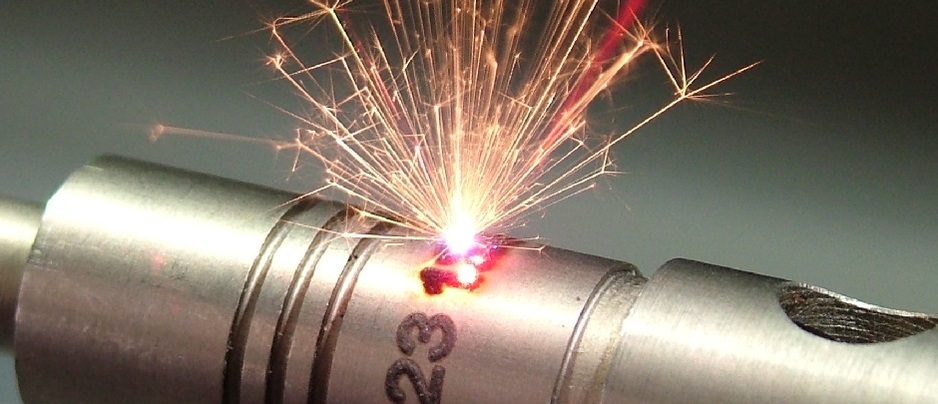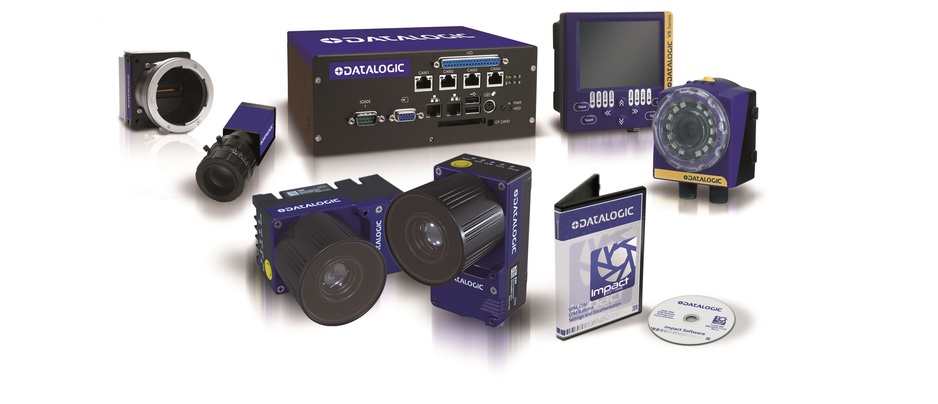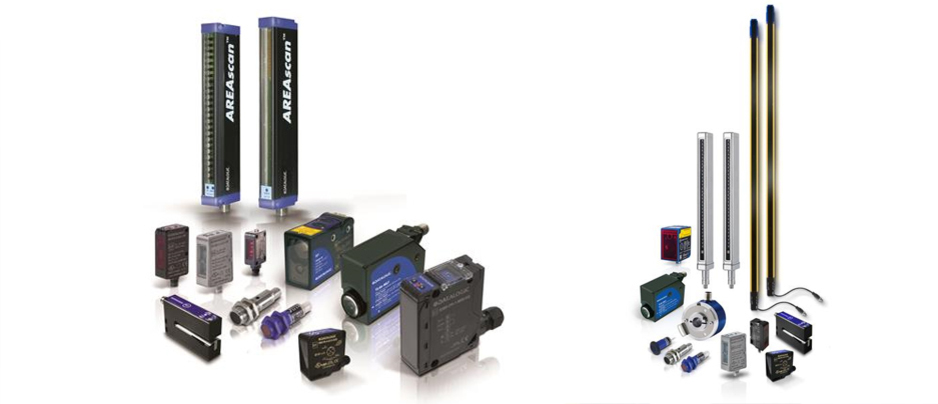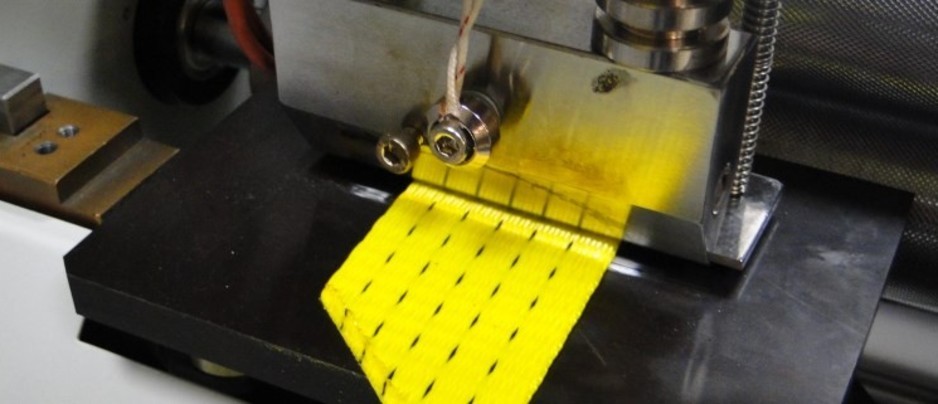
Laser marking
Laser marking is the practice of methods to leave marks on an object - modify the optical appearance of a surface that are hit by laser beam, which include laser engraving, color change due to chemical/molecular alteration, charring, foaming, melting, ablation, and more. The technique does not involve the use of inks, nor does it involve tool bits which contact the marking surface and wear out, giving it an advantage over alternative engraving or marking technologies where inks or bit heads have to be replaced regularly. Laser marking can occur through a variety of mechanisms such as ablation of material, melting a metal, slight burning, transformation of pigments, expansion of polymer, generation of surface structures such as small bubbles
The impact of laser marking has been more pronounced for specially designed "laserable" materials and also for some paints. These include laser-sensitive polymers and novel metal alloys.
By scanning the laser beam it is possible to quickly mark letters, symbols, barcodes, logos. Laser marking has a huge variety of applications: direct part marking, part numbers, valid until dates, logos, on bottles, metals, PCB's, cables and other materials.
The term laser marking is also used as a generic term covering a broad spectrum of surfacing techniques including printing, hot-branding and laser bonding. The machines for laser engraving and laser marking are the same, so that the two terms are sometimes confused by those without knowledge or experience in the practice.
A laser engraving machine can be thought of as three main parts: a laser, a controller, and a surface. The laser is like a pencil - the beam emitted from it allows the controller to trace patterns onto the surface. The controller controls the direction, intensity, speed of movement, and spread of the laser beam aimed at the surface. The surface is picked to match what the laser can act on.
Compared with other marking technologies such as ink jet printing and mechanical marking, laser marking has a number of advantages, such as very high processing speeds, low operation cost (no use of consumables), constant high quality and durability of the results, avoiding contaminations, the ability to write very small features, and very high flexibility in automation.
Plastic materials, wood, cardboard, paper, leather and acrylic are often marked with relatively low-power CO2 lasers. For metallic surfaces, these lasers are less suitable due to the small absorption at their long wavelengths (around 10 μm); laser wavelengths e.g. in the 1-μm region, as can be obtained e.g. with lamp- or diode-pumped Nd:YAG lasers (typically Q-switched) or with fiber lasers, are more appropriate. Typical laser powers used for marking are of the order of 10 to 100 W. Shorter wavelengths such as 532 nm, such as obtained by frequency doubling of YAG lasers, can be advantageous, but such sources are not always economically competitive. For marking of metals like gold, which has too low absorption in the 1-μm spectral region, short laser wavelengths are essential.
The impact of laser marking has been more pronounced for specially designed "laserable" materials and also for some paints. These include laser-sensitive polymers and novel metal alloys.
By scanning the laser beam it is possible to quickly mark letters, symbols, barcodes, logos. Laser marking has a huge variety of applications: direct part marking, part numbers, valid until dates, logos, on bottles, metals, PCB's, cables and other materials.
The term laser marking is also used as a generic term covering a broad spectrum of surfacing techniques including printing, hot-branding and laser bonding. The machines for laser engraving and laser marking are the same, so that the two terms are sometimes confused by those without knowledge or experience in the practice.
A laser engraving machine can be thought of as three main parts: a laser, a controller, and a surface. The laser is like a pencil - the beam emitted from it allows the controller to trace patterns onto the surface. The controller controls the direction, intensity, speed of movement, and spread of the laser beam aimed at the surface. The surface is picked to match what the laser can act on.
Compared with other marking technologies such as ink jet printing and mechanical marking, laser marking has a number of advantages, such as very high processing speeds, low operation cost (no use of consumables), constant high quality and durability of the results, avoiding contaminations, the ability to write very small features, and very high flexibility in automation.
Plastic materials, wood, cardboard, paper, leather and acrylic are often marked with relatively low-power CO2 lasers. For metallic surfaces, these lasers are less suitable due to the small absorption at their long wavelengths (around 10 μm); laser wavelengths e.g. in the 1-μm region, as can be obtained e.g. with lamp- or diode-pumped Nd:YAG lasers (typically Q-switched) or with fiber lasers, are more appropriate. Typical laser powers used for marking are of the order of 10 to 100 W. Shorter wavelengths such as 532 nm, such as obtained by frequency doubling of YAG lasers, can be advantageous, but such sources are not always economically competitive. For marking of metals like gold, which has too low absorption in the 1-μm spectral region, short laser wavelengths are essential.

Video inspection systems
Machine Vision video inspection systems are designed for production control, defective goods identification, sorting, OCR, barcode scanning. The system consists of a camera (or several of them), controller and software that processes the received images and performs certain actions on defined scenarios. The system can be relatively simple or extremely complex.
As simple example we can take DataLogic Impact + OCR kit, which can be used to inspect the products travelling on conveyor line, scan a bar code, identify expiration dates and so on. Then accordingly carry out certain commands, activate relays, stop the line or execute other predefined actions.
Machine Vision systems are able to distinguish good products from defective ones, we define what should be treated as good (or bad) image, the camera captures an image of product moving on a conveyor line, system compares it with a predefined image, if there are any differences, program activates defined scripts and the product is removed from the line. This saves valuable time on tracing the error cause, returns, and human resources for quality control.
These devices can be used for:
• Damaged packages inspection
• Reading text from packaging, expiry dates, batch, lot numbers, verification
• Bottle cap, authentification mark presence or absence, positioning on the container
• Medical device assembly inspection
• Syringe needle precision inspection
• Electronic components positioning and inspection
• Roll material defect control
• Robotic arm movement, keeping track and directing
• Product counting
• Measurements
• Sorting
• And many other areas
IMPACT software has more than 120 inspection tools and 50 user interface controls, which allows the user to easily create a unique inspection programs and user interfaces that can be achieved without the loss of flexibility what is often impossible in traditional systems. IMPACT software package also has an enclosed SDK, so you can according to the corporate need integrate this package into existing systems.
Visio Program Manager has hundreds of image processing and analysis functions, with their help we are able to capture images, make measurements of objects, their presence / absence, read text or barcode.
Control Panel Manager facilitates the creation of operator panels and their corrections.
We can also offer dimensional scanning equipment. Special equipment scans an object moving on a conveyor line, measure the volume of the product as well as the all three dimensions. If the product is irregular shape, the minimum dimensions are approximated of a rectangle that in which the product would fit. Such equipment is essentially relevant to the logistics companies which calculate the price accordingly to the weight and volume of the parcel. Also volume measurement relevant for sorting lines and production performance calculations.
All these devices, including barcode scanners can also be used for performance monitoring, product calculation or rejects / good product ratios. Using special software one can easily display real-time data, perform analysis, and so on. Despite the primary purpose of the device, customer receives and additional functionality and result of which is beneficial for your business success!
As simple example we can take DataLogic Impact + OCR kit, which can be used to inspect the products travelling on conveyor line, scan a bar code, identify expiration dates and so on. Then accordingly carry out certain commands, activate relays, stop the line or execute other predefined actions.
Machine Vision systems are able to distinguish good products from defective ones, we define what should be treated as good (or bad) image, the camera captures an image of product moving on a conveyor line, system compares it with a predefined image, if there are any differences, program activates defined scripts and the product is removed from the line. This saves valuable time on tracing the error cause, returns, and human resources for quality control.
These devices can be used for:
• Damaged packages inspection
• Reading text from packaging, expiry dates, batch, lot numbers, verification
• Bottle cap, authentification mark presence or absence, positioning on the container
• Medical device assembly inspection
• Syringe needle precision inspection
• Electronic components positioning and inspection
• Roll material defect control
• Robotic arm movement, keeping track and directing
• Product counting
• Measurements
• Sorting
• And many other areas
IMPACT software has more than 120 inspection tools and 50 user interface controls, which allows the user to easily create a unique inspection programs and user interfaces that can be achieved without the loss of flexibility what is often impossible in traditional systems. IMPACT software package also has an enclosed SDK, so you can according to the corporate need integrate this package into existing systems.
Visio Program Manager has hundreds of image processing and analysis functions, with their help we are able to capture images, make measurements of objects, their presence / absence, read text or barcode.
Control Panel Manager facilitates the creation of operator panels and their corrections.
We can also offer dimensional scanning equipment. Special equipment scans an object moving on a conveyor line, measure the volume of the product as well as the all three dimensions. If the product is irregular shape, the minimum dimensions are approximated of a rectangle that in which the product would fit. Such equipment is essentially relevant to the logistics companies which calculate the price accordingly to the weight and volume of the parcel. Also volume measurement relevant for sorting lines and production performance calculations.
All these devices, including barcode scanners can also be used for performance monitoring, product calculation or rejects / good product ratios. Using special software one can easily display real-time data, perform analysis, and so on. Despite the primary purpose of the device, customer receives and additional functionality and result of which is beneficial for your business success!
DS-IMPACT_OCR-ENA4.pdf
Digital_Wheel.pdf
PG-MachineVision-ENA4.pdf
Plastics_Web.pdf
Single_Camera_Inspecting.pdf

Industrial sensors
In the broadest definition, a sensor is an object whose purpose is to detect events or changes in its environment, and then provide a corresponding output. A sensor is a type of transducer; sensors may provide various types of output, but typically use electrical or optical signals. For example, a photoelectric sensor is a device used to detect the distance, absence or presence of an object, as well as to distinguish different items on the basis of their light absorption and reflection properties. A photoelectric sensor consists of an emitter and receiver unit, coupled by either a modulated LED or LASER light beam. Photoelectric sensors are available in three different functional types depending the environment and the detection objects physical properties: through beam, retro-reflective, and proximity. These sensors are ideal for generic industrial applications such as counting, presence control, or automatic positioning. In addition, Datalogic offers solutions in a variety of applications such as contrast reading, distance and area measuring, as well as luminescence and color detection.
We can offer you a wide range of photoelectric, proximity, inductive proximity, ultrasonic, light array sensors, rotary encoders, temperature controllers.
Feel free to contact us and we will help you to choose the best option!
We can offer you a wide range of photoelectric, proximity, inductive proximity, ultrasonic, light array sensors, rotary encoders, temperature controllers.
Feel free to contact us and we will help you to choose the best option!

Textile ribbon cutting equipment
Professional fully automatic textile ribbon cutting equipment by cold, hot or ultrasonic knifes.
Different cut line shapes are possible, r
Different cut line shapes are possible, r

